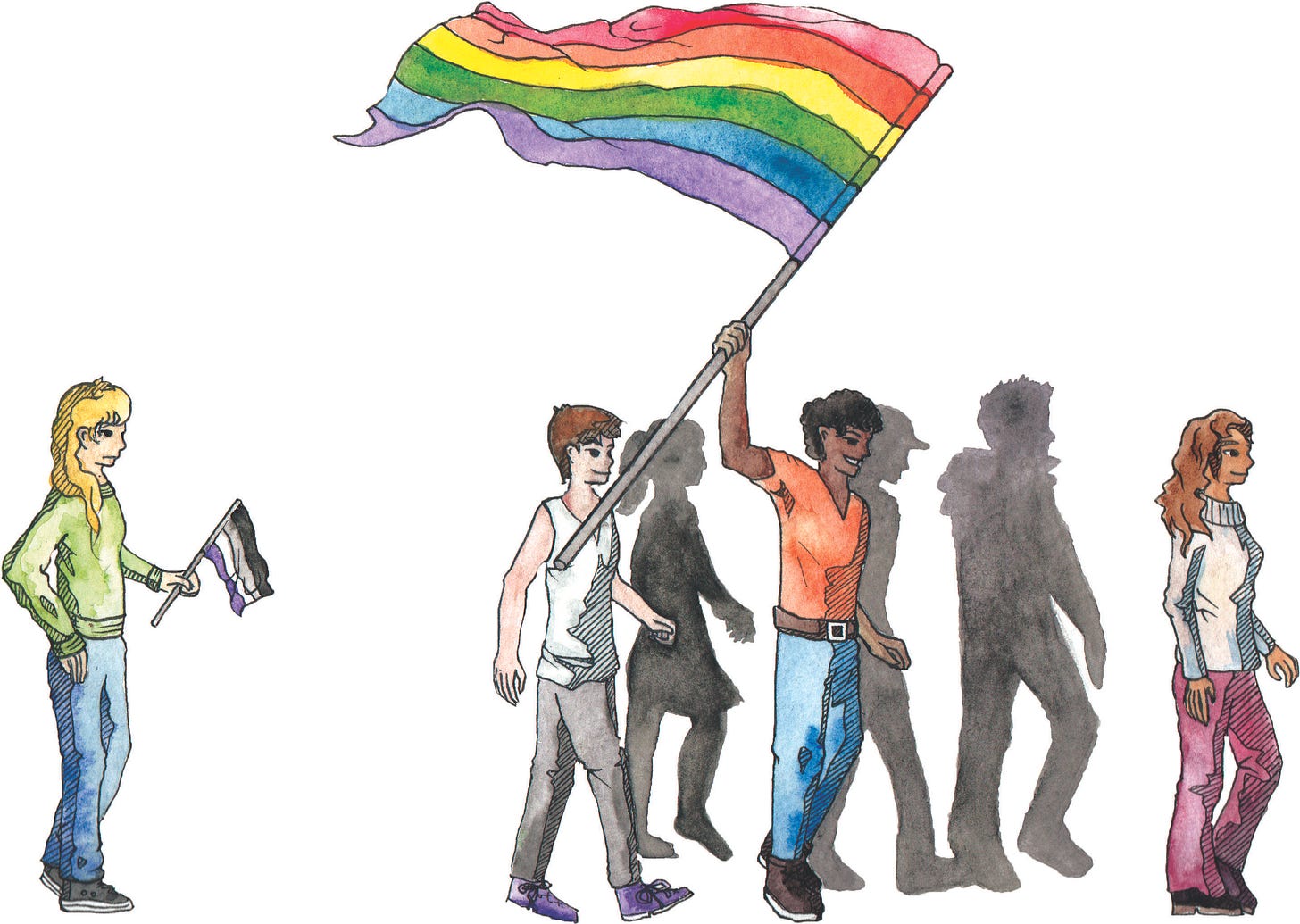Queerness includes asexuality
Here's why
Is asexuality queer? As a sexuality researcher, I unreservedly think the answer is yes. Yet, despite being one of the ‘A’s in LGBTQIA+ (along with agender and aromantic), asexuality’s place among the queer community is often uncertain.
In my interviews with asexual people, many said they feel uncertain calling themselves queer. Some of my asexual research participants even said that other members of the LGBTQIA+ have explicitly told them that asexual people aren’t queer.
As a non-asexual (aka allosexual) queer person, I’ve seen how these exclusionary attitudes toward asexual folks are simply wrong—and harmful to the queer community more broadly.
So here we go: a simplified argument of why queerness includes asexuality.
What is queerness anyway?
It’s convenient to think of queerness as simply being the “opposite” of heterosexuality, framing anything that isn’t hetero as queer.
But this is a misleading—and limiting—definition of queerness.
Queerness isn’t defined in opposition to heterosexuality; it’s defined in opposition to heteronormativity, which refers to the normalization of heterosexuality as natural and ideal (and anything else as unnatural and less than ideal).
But even this definition is a bit limiting. As we’ve come to learn more about gender and sexuality, it’s become increasingly clear that queerness is about challenging gender and sexual normativity more broadly.
Heteronormativity is simply one flavor of normativity. But there are many others, and it’s vital that the queer movement build our knowledge about all of them. In fact, I see this as a major benefit of taking asexuality seriously: it helps reveal other types of normativity that are otherwise easy to miss.
Digging into normativity
Queerness is about resistance to normativity. Asexuality clearly meets that definition: although some asexual people do experience hetero-oriented desire, asexuality certainly isn’t normative.
Heteronormativity is the most broadly-known iteration of normative ideology. My years of researching asexuality have convinced me that asexuality presents important challenges to heteronormativity. Namely, asexuality reveals compulsory sexuality (or the assumption and enforcement of sexuality) as an important, but hidden, building block of compulsory heterosexuality (or the assumption and enforcement of heterosexuality).
In my view, however, one of the greatest strengths of centering asexuality in queer activism is that asexual perspectives helps remind us that heternormativity works hand-in-hand with various other kinds of normativity.
In addition to heteronormativity, there’s:
Allonormativity: the assumption that it’s normal and ideal to experience sexual attraction
Mononormativity: the assumption that monogamy is normal/ideal
Amatonormativity: the assumption that it’s normal/ideal to pursue love/romance
Cisnormativity: the assumption that it’s normal/ideal to identify with your assigned gender at birth
The importance of asexuality to queer activism
Asexuality helps us better understand that allonormativity is a core building block of sexual oppression. Similarly, aromanticism (which refers to those who experience no/low romantic attraction) helps us see that amatonormativity plays a related oppressive role. We should welcome these as important queer lessons.
Insisting that asexuality isn’t queer feeds into normative assumptions rather than challenging them. Ironically, insisting that queerness can only look a certain way runs dangerously close to forging a new normativity that we might call “queernormativity.”
Queerness can emerge and exist in various different ways. Just because asexuality looks different from your experience of queerness doesn’t mean it’s not queer. Including asexuality expands queerness. It helps us better understand the fights still ahead of us.
Gatekeeping who “is” and “isn’t” queer is generally unproductive, especially when it’s so clear that asexual people present important challenges to the tangled web of sexual oppression.
So let’s stop the gatekeeping. Liberation isn’t a limited resource. We don’t have to guard it.
Want to support my research on asexuality? Consider becoming a contributing subscriber by clicking on the button above. You can also subscribe for free or follow me on Twitter @CantonWiner. Regardless of whatever decision you make, I am committed to keeping my work free, without paywalls. Consider your paid membership a token of appreciation, an investment in research on asexuality, and a small but meaningful way to join a community that shares your interests.



Thank you so much for writing this article and for all your research on asexuality!! It took me so long to reach a similar conclusion that I'm ace AND queer (after denying myself/feeling excluded from queerness for a long time...) and your words are so affirming. I find that the opposition to normativity + ways I center non-romantic/non-sexual kinship like friendship are the main things that queerness means to me, as an ace person :-).
Thank you so so so much for this. I can’t tell you how many aphobes and exclusionists I’ve come across simply for my daring to say I’m ace and that that belongs in the queer community. I’m always having to point out that Stonewall also included aces, but those people who don’t think we should be included at all never want to consider the fact that we’ve always been in the community and always will be. I really appreciate you and your research on why we belong.